In England, 70% of adults are mostly overweight or obese. This shows the importance of a balanced diet plan. Eating right is key to staying healthy and avoiding chronic diseases. A good diet includes whole grains, fruits, veggies, lean proteins, and healthy fats.
By controlling portions and focusing on macronutrients, you can make a meal plan that fits your life. This way, you can enjoy a balanced diet every day.
The USDA says adults need 1,600 to 3,000 calories daily for a balanced diet. It’s important to eat a variety of foods. This includes whole grains, fruits, veggies, lean proteins, and healthy fats. Following a healthy eating plan and controlling portions helps you get the nutrients you need for good health.
What is a Balanced Diet?
A balanced diet is key for good health. It means eating a variety of foods from all food groups. The amount of calories you need daily depends on your age, sex, and how active you are. On average, people need about 2,000 calories a day.
It’s important to eat foods rich in vitamins and minerals. These include whole grains, fruits, vegetables, lean proteins, and healthy fats. They help keep your body working right.
The NHS says you should eat at least 5 portions of different fruits and vegetables every day. A balanced diet includes:
- Fruits and vegetables
- Whole grains
- Lean proteins
- Healthy fats
Eating a variety of foods from all food groups helps you get the nutrients you need. It’s also important to think about how many calories you eat and the role of vitamins and minerals in your diet.
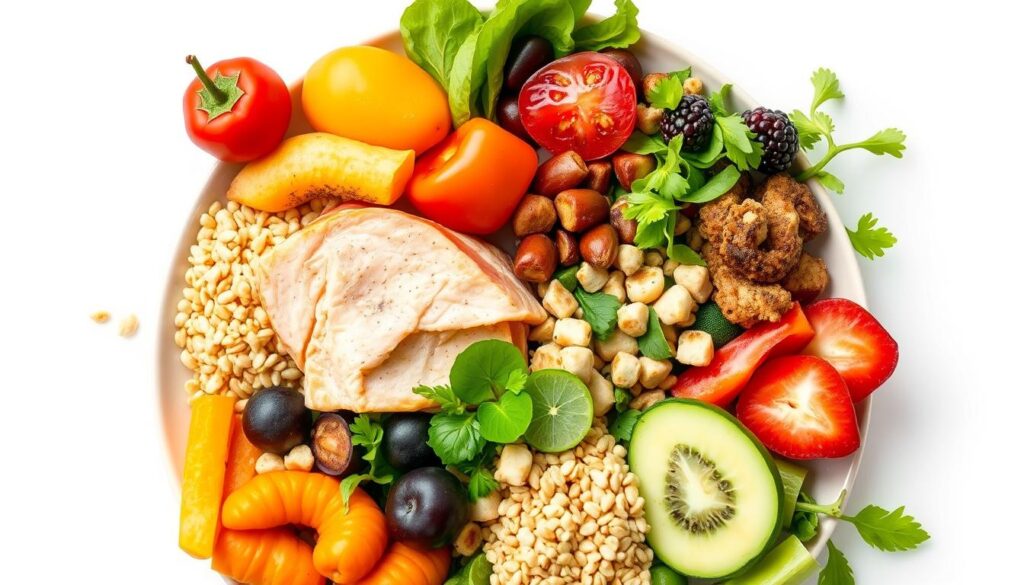
But a balanced diet is more than just eating healthy foods. It’s also about living a healthy lifestyle. Making smart food choices and staying active can help prevent chronic diseases and keep you healthy.
| Food Group | Recommended Daily Intake |
|---|---|
| Fruits | 2 cups |
| Vegetables | 2.5-3.5 cups |
| Grains | 6 ounces |
Benefits of Healthy Eating
Eating healthy boosts your energy levels and metabolism. It helps with weight loss or muscle gain too. The Academy of Nutrition and Dietetics says it lowers the risk of heart disease, type 2 diabetes, and some cancers.
Healthy eating offers many benefits, including:
- Improved heart health
- Increased energy levels
- Support for a diet for weight loss or diet for muscle gain
- Reduced risk of chronic diseases
Physical Health Benefits
Healthy eating improves heart health and boosts energy levels. It also aids in weight loss or muscle gain, based on your goals.
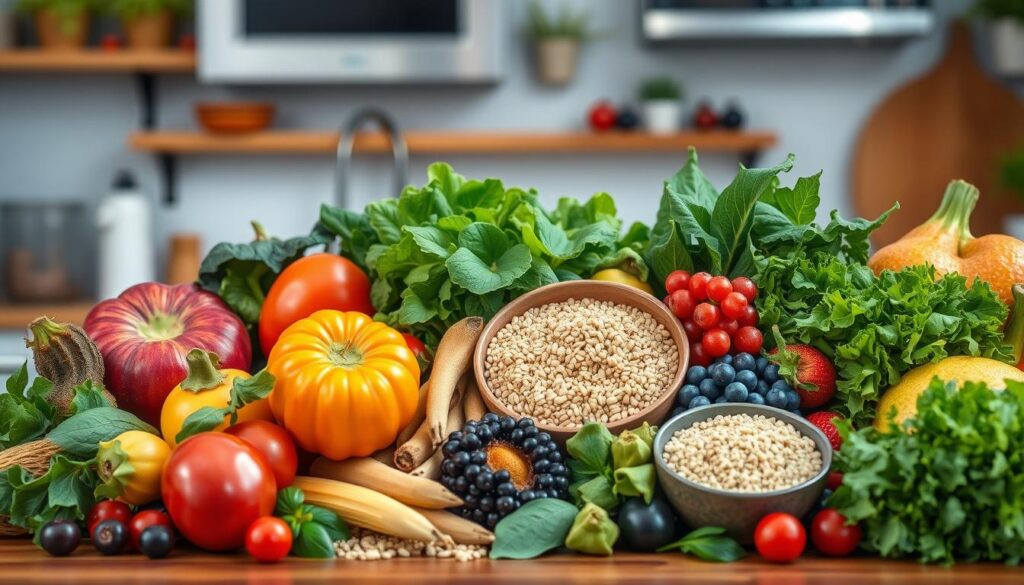
Mental Health Benefits
Healthy eating also benefits your mind, lowering stress and anxiety. It enhances metabolism and overall health and well-being.
Foods to Include in a Balanced Diet
A balanced diet should have foods from all groups. Focus on whole grains, fruits, vegetables, lean proteins, and healthy fats. Fruits and vegetables are key for vitamins and minerals. Include different colors to get a variety of nutrients.
The USDA says to eat a variety of fruits and vegetables. Dark leafy greens, citrus fruits, and berries are good choices. Healthy options include apples, avocados, bananas, and strawberries. Whole grains like brown rice and quinoa offer fiber. Lean proteins from poultry and fish help muscles grow.
Nutrient-Dense Foods
Here are some nutrient-dense foods for a balanced diet:
- Leafy greens, such as kale and spinach
- Citrus fruits, such as oranges and berries
- Whole grains, such as brown rice and quinoa
- Lean proteins, such as poultry and fish
- Healthy fats, such as nuts and seeds
Plant-based diets are also good, focusing on whole grains, fruits, vegetables, and lean proteins. A balanced diet should include foods from all groups. It should also match your individual needs and likes.
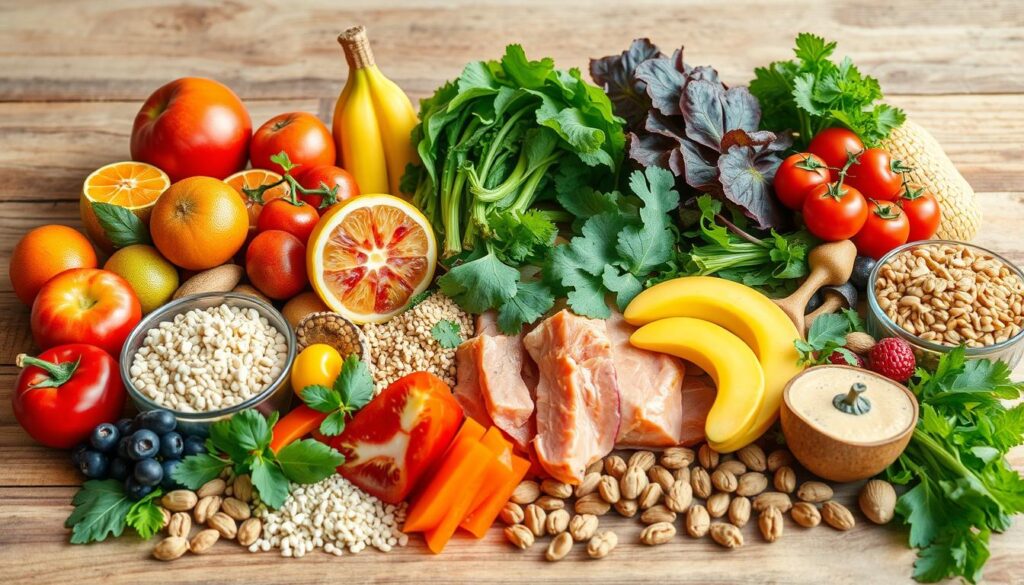
Creating a Balanced Meal Plan
| Food Group | Recommended Daily Intake |
|---|---|
| Fruits and Vegetables | 5-6 servings |
| Whole Grains | 4-6 servings |
| Lean Proteins | 2-3 servings |
| Healthy Fats | 2-3 servings |
By mixing whole grains, lean proteins, fruits, and vegetables, you can make a balanced meal plan. This plan meets your nutritional needs and supports your health and well-being.
Portion Sizes and Serving Recommendations
Knowing how much to eat is key to staying healthy and avoiding diseases. The American Heart Association suggests using a food scale or measuring cups. This helps you eat just enough, not too much.
It’s also vital to know how much to eat from each food group. The Dietary Guidelines for Americans, 2020–2025, give tips on calorie needs based on age, gender, and activity level. For example, adults needing 2,000 calories a day should aim for 2 ½ cups of veggies and 2 cups of fruit daily.
To choose healthy foods, use tools like the MyPlate Plan and the Nutrition Facts label. The FDA’s Nutrition Facts label shows calories, fats, protein, carbs, and more per serving. These tools help you pick the right amounts of food and drinks.
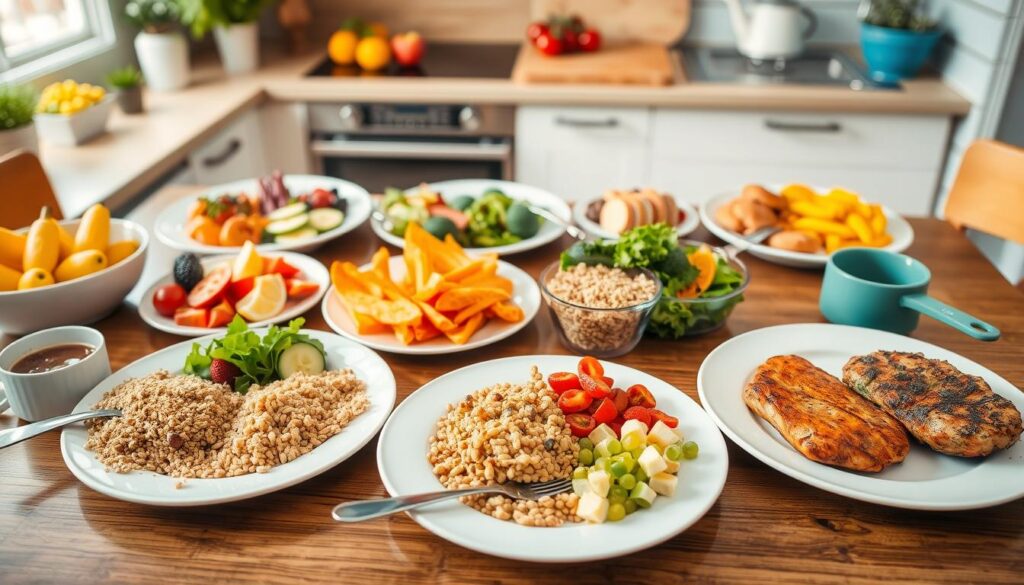
At home, you can manage food portions by using smaller plates and bowls. Freezing leftovers helps avoid eating too much. Eating regular meals also stops unhealthy snacking. Focus on eating lots of veggies, fruits, whole grains, legumes, nuts, fish, and healthy oils to stay balanced and healthy.
| Food Group | Recommended Daily Servings |
|---|---|
| Vegetables | 2 ½ cups |
| Fruit | 2 cups |
| Whole Grains | 3-6 servings |
| Dairy | 3 servings |
| Protein | 1-2 servings |
| Fats | 2-3 servings |
Planning Your Balanced Diet
Planning a balanced diet is easy with a few simple tips. The Academy of Nutrition and Dietetics says planning meals ahead helps make healthy choices and cuts down on waste. By using meal planning tips daily, you save time and money and move closer to your health goals.
To start, make a weekly menu with lots of healthy foods. This ensures you get all the nutrients you need for good health. Here are some tips for your weekly menu:
- Plan meals around seasonal produce for freshness and variety.
- Balance each meal with protein, healthy fats, and complex carbs.
- Think about your dietary needs and likes, like vegetarian or gluten-free.
By following these tips and making a few dietary changes, you can reach your health goals. Don’t forget to drink plenty of water and avoid sugary drinks. With a bit of planning and creativity, you can make a diet that’s balanced and works for you.

| Food Group | Recommended Daily Intake |
|---|---|
| Fruits and Vegetables | 5-7 servings |
| Protein | 2-3 servings |
| Whole Grains | 3-5 servings |
Incorporating Snacks into Healthy Eating
Healthy snacks are great for your health and well-being. The USDA says snacks can be part of a balanced diet if they’re full of nutrients and low in bad stuff. Choosing the right snacks and eating mindfully can help you stay healthy and avoid chronic diseases.
Good snack choices include fruits, veggies, nuts, and seeds. Also, whole grain crackers with hummus are great. These snacks give you the nutrients you need and help you feel full between meals. Snacks should give you energy and support your health.
Here are some tips for healthy snacking:
- Choose nutrient-dense snacks, such as fruits and vegetables
- Limit snacks high in added sugars, salt, and unhealthy fats
- Practice mindful eating, paying attention to hunger and fullness cues
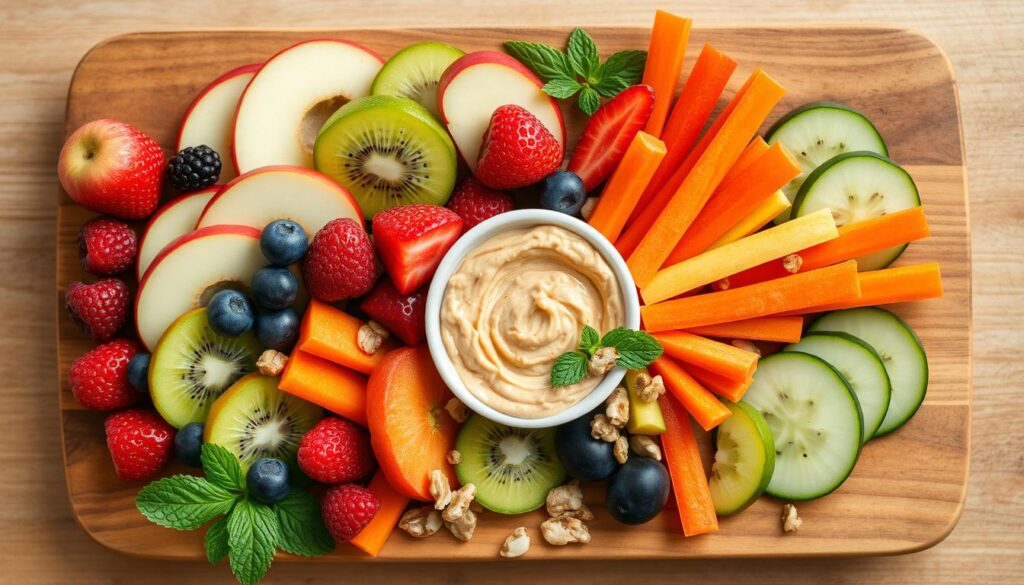
By following these tips, you can improve your health. Always pick snacks that are good for you and eat them mindfully. This way, you’ll get the most out of your snacks.
| Snack | Calories | Nutrients |
|---|---|---|
| Apple | 95 | Fiber, Vitamin C |
| Carrot sticks with hummus | 100 | Vitamin A, Fiber |
| Almonds | 161 | Protein, Healthy Fats |
Special Dietary Considerations
Some people need to follow special diets for health reasons. A vegan diet can be healthy if you eat a variety of plant-based foods. The Academy of Nutrition and Dietetics says a vegan diet is good for those who want to eat more plants.
Others might need to eat gluten-free because of gluten intolerance. A gluten-free diet can be healthy if you eat whole grains and avoid too much sugar, salt, and bad fats. If you can’t digest lactose, you might need to drink lactose-free milk.
It’s important to read food labels and avoid foods that might cause allergic reactions. Here are some healthy choices:
- Fortified soy alternatives
- Canned sardines and salmon as good sources of calcium
- Whole grains, such as brown rice and quinoa
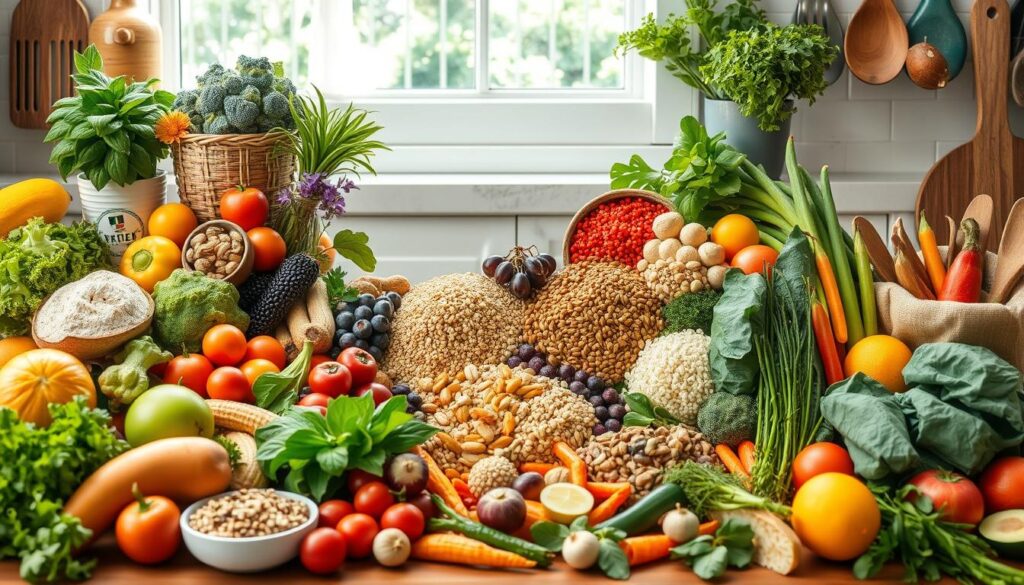
Understanding and meeting your dietary needs helps you stay healthy. It ensures you get the nutrients you need for good health.
Common Myths about Balanced Diets
When it comes to fitness and health, many myths can lead to bad eating habits. One big myth is that all carbs are bad or all fats are unhealthy. But, not all carbs and fats are the same. Knowing the difference is key to a balanced diet.
The American Heart Association says many diet fads are harmful. Calorie tracking is also key for making smart food choices. By clearing up diet myths about carbs and fats, we can eat healthier and stay balanced.
Debunking Diet Fads
Some diets, like low-carb or low-fat, can be bad for health. They often cut out whole food groups, leading to missing nutrients and unhealthy eating. Eating a variety of whole foods, like fruits, veggies, whole grains, and lean proteins, is best for staying healthy.
Misconceptions about Carbs and Fats
Many think all carbs are bad or all fats are unhealthy. But, it’s not true. Foods like brown rice, quinoa, and whole-wheat bread are good carbs. Foods like avocados, nuts, and olive oil are good fats. Adding these to your diet helps with calorie tracking and supports health.
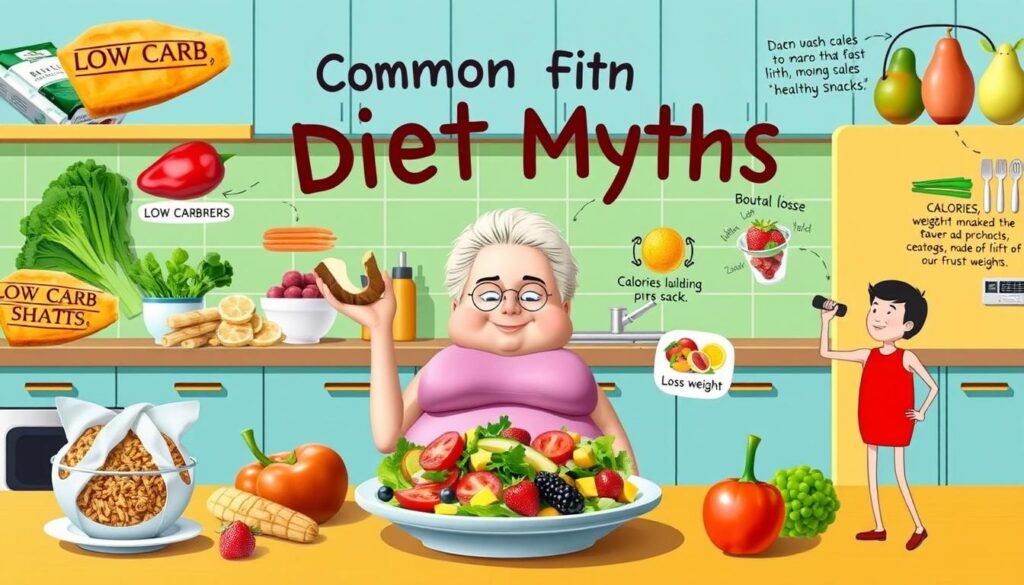
Knowing the truth about carbs and fats helps us make better diet choices. A healthy diet is about variety and balance. And calorie tracking is a big help in keeping a healthy weight.
| Food Group | Healthy Options | Unhealthy Options |
|---|---|---|
| Carbs | Whole grains, fruits, vegetables | Refined sugars, white bread |
| Fats | Avocados, nuts, olive oil | Saturated fats, trans fats |
Monitoring Your Diet
Keeping track of your diet is easy with food journals and apps. The Academy of Nutrition and Dietetics says a food journal helps you monitor your eating. It’s great for calorie tracking and staying balanced.
Tracking your food helps you spot patterns and make better choices. This leads to sustainable eating habits, which are key for health. Apps also offer grocery shopping tips and recipes to help you stay on track.
Keeping a Food Journal
A food journal is a powerful tool for diet monitoring. It helps you track habits and make changes. Here are some tips:
- Write down everything you eat and drink
- Include the time of day and the portion size
- Note how you feel after eating, such as full or satisfied
Using Apps for Healthy Eating
Many apps can help you monitor your diet and make healthy changes. Some top picks include:
| App | Features |
|---|---|
| MyFitnessPal | Calorie tracking, macronutrient tracking, healthy recipes |
| Lose It! | Calorie tracking, weight loss tracking, healthy recipes |
![]()
Staying Motivated with Healthy Eating
Staying motivated with healthy eating is key to reaching health goals and keeping a balanced diet. The American Heart Association says setting realistic goals and having a support system helps. This means making dietary adjustments like eating five servings of fruits and vegetables daily.
A support system can give extra motivation and help. It can be joining a weight loss group or having a workout buddy. With motivation and support, you can keep a balanced diet and hit your health goals.
Here are some tips to stay motivated with healthy eating:
- Set realistic goals, like eating a certain number of servings of fruits and vegetables daily.
- Build a support system, like joining a weight loss group or finding a workout buddy.
- Track your progress, using a food diary or mobile app to monitor your eating habits.

By using these tips and staying motivated, you can reach your health goals and keep a balanced diet. Remember, staying motivated with healthy eating is a journey. It’s okay to take it one step at a time.
| Tip | Description |
|---|---|
| Set realistic goals | Set specific, achievable goals, such as eating five servings of fruits and vegetables per day |
| Build a support system | Join a weight loss group or find a workout buddy to provide motivation and guidance |
| Track progress | Use a food diary or mobile app to track eating habits and stay motivated |
The Role of Hydration in a Balanced Diet
Drinking enough water is key for good health. The National Academies say we should drink at least eight cups a day. Water helps with digestion and getting nutrients from our food.
Some foods also help us stay hydrated. For example, watermelon is mostly water and full of vitamins A and C. Eating less sodium can also help avoid dehydration, as too much salt can upset our body’s water balance.

But, we should watch out for drinks that can dry us out. Caffeine, alcohol, and sweet drinks can do this. Drinking water and choosing healthy drinks is important for a balanced diet. Eating at the right times helps our body get what it needs all day.
Here are some hydrating foods to try:
- Watermelon
- Cucumbers
- Celery
These foods add extra water and support health, making them great for a balanced diet.
Conclusion: Embracing a Balanced Diet for Life
Getting a balanced diet is more than a quick fix. It’s a long-term promise to care for your health and happiness. By adding whole grains, lean proteins, fruits, and vegetables to your meals, you keep your body nourished.
Healthy eating is a journey, not a quick fix. It needs a long-term view and lasting habits. This means meal planning, buying balanced ingredients, and cooking at home. These steps help you stick to your daily meal plan and give your body what it needs.
A balanced diet isn’t about being perfect. It’s about finding a way that fits your life. Get advice from health experts like nutritionists or dietitians. They can help you make choices that support your health goals. By focusing on your well-being, you start a journey of balanced nutrition and a better life.





















